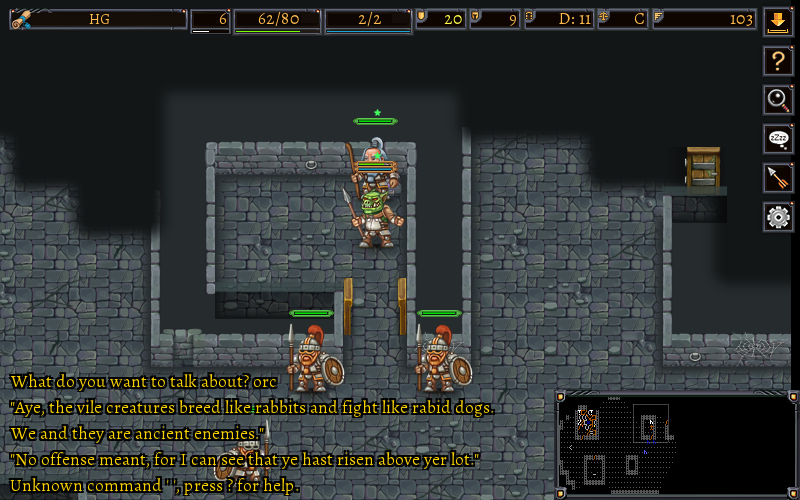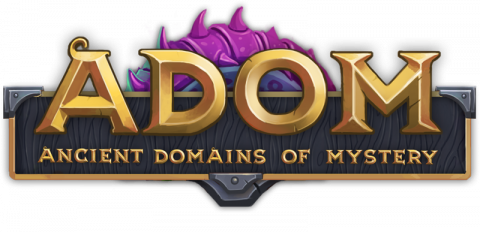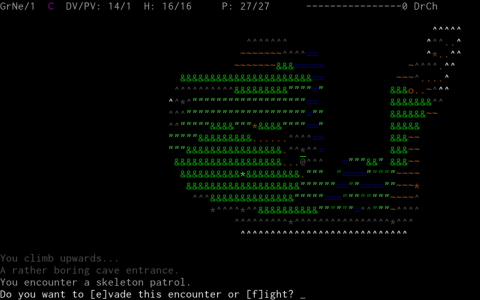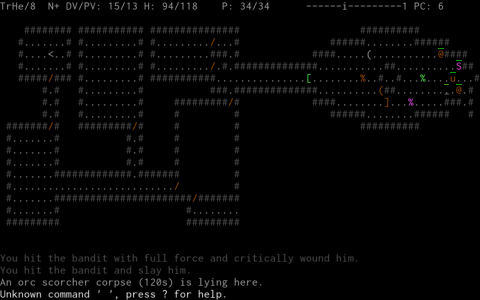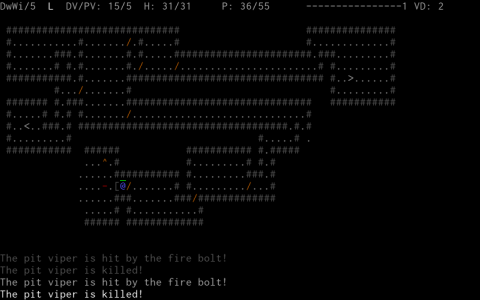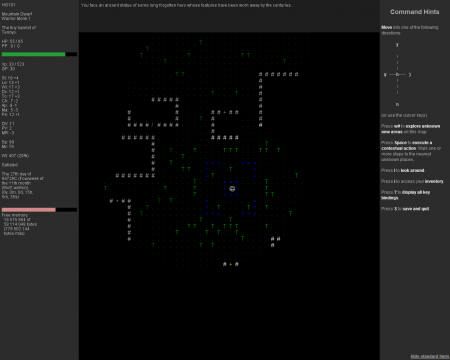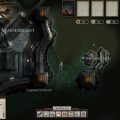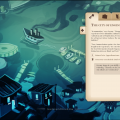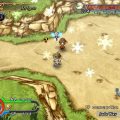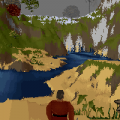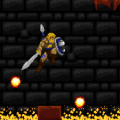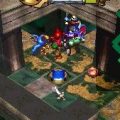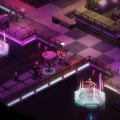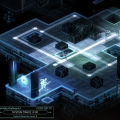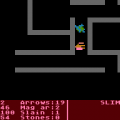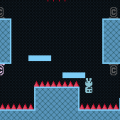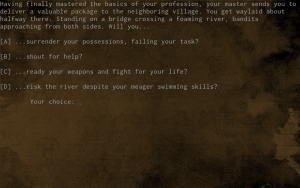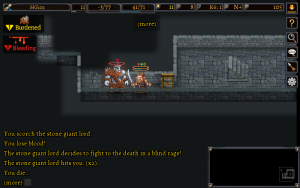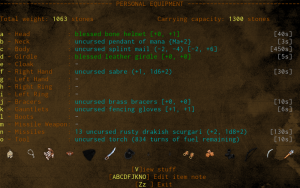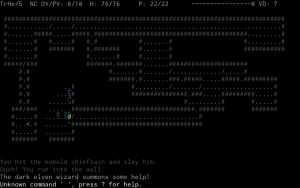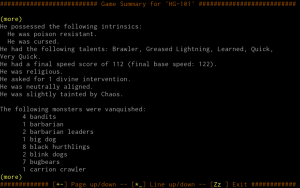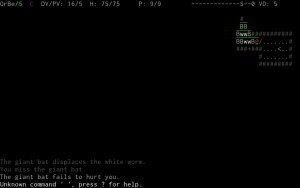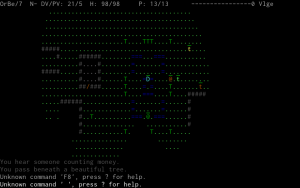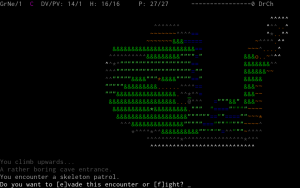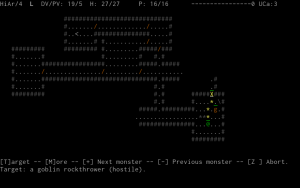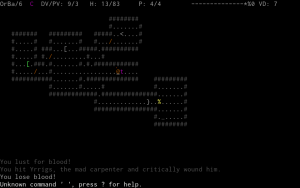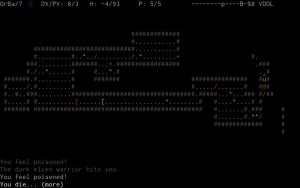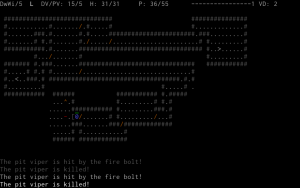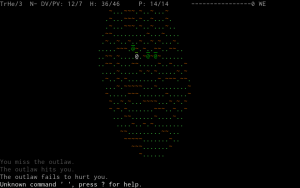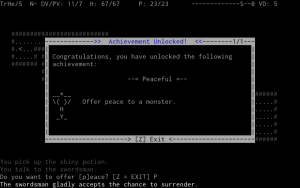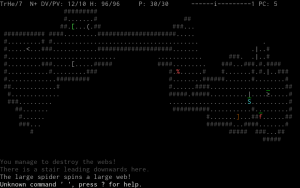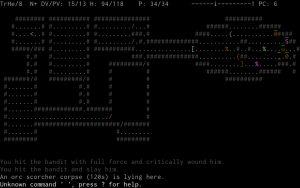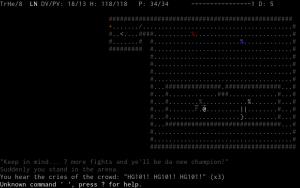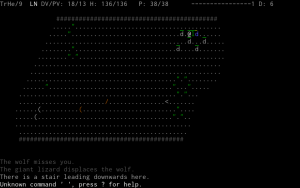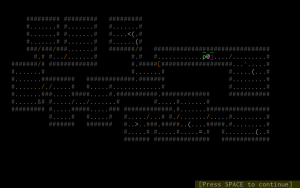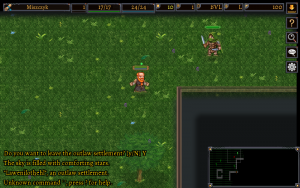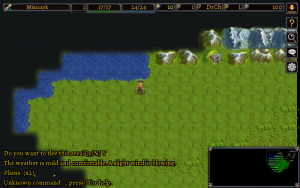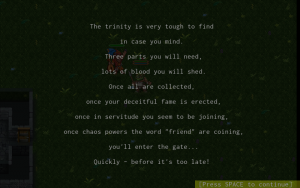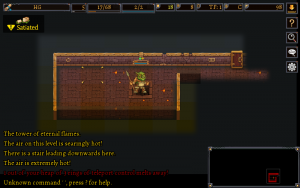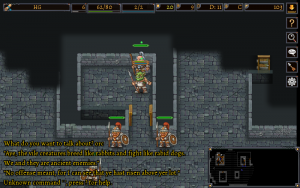Ancardia is a fantasy world not unlike other fantasy worlds: it has elves who’re long-lived experts in magic and archery, short but strong dwarves living in the mountains, evil orcs, trolls whose strength is only rivaled by their appetite and medieval-style humans who make living through farming, committing crimes or fighting crime through liberal application of swords. It’s a world filled with caves, dungeons and mountains in which mysterious and powerful artifacts can be found. Unfortunately for its inhabitants, it’s also being attacked by forces of chaos which arrive from the mountains of Drakalor Chain, killing everything on their way and corrupting survivors until they become servants of chaos themselves.
Naturally, Drakalor Chain quickly becomes a destination for many adventurers who’re trying to find the reason for the invasion and stop it before it’s too late. Player can be one of them, although it’s also possible to arrive in Drakalor Chain as a chaos knight – a strong and well-equipped but universally hated inhabitant of Ancardia who betrayed his people and decided to aid the chaotic invaders. Ancient Domains of Mystery has multiple endings: while only the select few will be able to complete the game by closing the Chaos Gate (which obviously does not end well for the aforementioned chaos knights), even fewer will find ways of crossing dimensions and either taking control of the forces of chaos or attaining even greater power.
From the description above, Ancient Domains of Mystery sounds like a standard cRPG and in fact it has many things in common with the genre: overworld map with towns and dungeons, quests, karma system. But the game is also a traditional roguelike with the level of complexity and difficulty similar to that of NetHack. While it’s not the first roguelike to feature those elements (they were pioneered by Omega and, to a certain extent, Larn), it’s arguably the best and most influential one.
The complexity of the game becomes obvious since the very beginning: the skills and stats of the new characters are determined by their randomized ‘starsign’ as well as player-defined sex, race and class, a randomized backstory and a short choose-your-own-adventure segment in which the player answers a set of questions (not unlike those at the beginning of Ultima IV, although each of them has not two but four answers) about the character’s life prior to arriving in Drakalor Chain. The stats are further affected by items, level, corruption and age (which increases with time spent in the game as well as with age-increasing attacks of certain monsters; each race ages differently, with orcs having their lifespans shorter than humans and mist elves living for tens of thousands of years) while the skills are increased through levelling up, reading books, training with NPCs and simply using them.
Characters in Ancient Domains of Mystery are further affected by intrinsic and extrinsic attributes (ranging from the useful – like the partial resistance or complete immunity to certain elements – to deadly – like the annoying ‘cursed’ and ‘doomed’ attributes) and corruptions they acquire while visiting certain places or fighting against chaos servants which cause their bodies to mutate. Most corruptions have both positive and negative effects (although some are clearly better than the others) but if too many are acquired, the game will end with the character transforming into a ‘writhing mass of primal chaos’, a dangerous but mindless monster.
While the bulk of complexity in NetHack came from multiple ways of using different items, Ancient Domains of Mystery is really all about character building. Different things from hitpoint regeneration rate to the time from killing a monster to its corpse starting to rot are affected by your skills (in this case: healing and food preservation). Other skills can affect combat, partially identify items or allow the player to cross difficult terrain. Some, despite looking like they were put in the game as a joke, have their uses: even bridge building, music and gardening can be quite helpful in certain circumstances.
The choice of character class has a big effect on the gameplay, especially when compared to NetHack where after a certain point, most of the characters (with an exception of monk) would be played the similar way. Ancient Domains of Mystery makes it difficult to acquire skill you don’t already have (which means that characters who start without healing will not regenerate HP for quite some time while the illiterate ones will be unable to use scrolls and books) which already means that starting skills matter but it also gives certain classes abilities which can’t be gained any other way. Mindcrafters and elementalists learn spells while leveling, monks can kick down doors while beastfighters and necromancers have ways of creating allies.
As Ancient Domains of Mystery is a very difficult game, careful planning of the character build is required. To win the game, minmaxing and working around the weakness is far more important than roleplaying. Knowing what kind of race/class combination is better for a given starsign, what skills should be increased and when to do it as well as what equipment is good for what playstyle can make a difference between the next hero of Arcandia and yet another clueless wanderer slaughtered by a group of bandits.
Ancient Domains of Mystery is a difficult game with many ways to die. Players can be killed by enemies, traps and angry gods. They can drown, get petrified, turn into chaos servants, get sacrificed to gods, starve and die of old age. Their items can be stolen or destroyed, resulting in them being unable to deal with the danger. Fortunately, it seems that it’s never impossible as there’s always some way to get out of tough situations.
A big part of the game’s difficulty is its obscurity. As Ancient Domains of Mystery is (unlike many other roguelikes) a closed-source game, players need to rely on its limited manuals and hints from the other players. To this day, the game has several secrets which the players were unable to discover, even by extracting data from the executable. It is unknown if weird tome has a purpose other than being an object of a fetch quest. Scroll of omnipotence may or may not exist and may or may not kill the player when read.
Some of the game’s mechanics are never really explained in-game. An example of one such feature is the behavior of herbs which, if the player is out of the level on which they grow for a randomly chosen period of time, die and/or spread like cells in Conway’s game of life. A late-game NPC will give you a powerful ring if you’ve never killed a cat during your game (yes, that includes hostile cave lions) and attack you if you did, and his strength is dependent on the number of cats you’ve killed. Where to go and what to do can often be unclear, especially if going for any of the special endings. ‘Ultra endings’ have the players acquire an extremely rare item to save a character who otherwise dies when they interact with him and kill a character who can dodge almost everything and hides on the level of infinite dungeon with a number equal to the number of times the player killed monsters of the same type as the monster they’ve first killed. While most of the extremely counterintuitive tasks are not required for just finishing the game, Ancient Domains of Mystery seems to be designed not for a player who beats the game without outside help but for a community which shares secrets, tips and strategies.
Despite the difficulty, there are several self-imposed characters possible for those who can consistently achieve even the most difficult endings. Some of them the game will keep track of and give achievements for – for example, finishing the game without visiting any of the optional locations. Others are all about bragging rights – for example, the ‘archmage’ build which is able to indefinitely cast the ‘wish’ spell, becoming nearly omnipotent but also requiring far more work than would be necessary for simply beating the game.
Ancient Domains of Mystery is a ‘hacklike’ game: most dungeons fit on a single screen (but only in ASCII mode) and are persistent (with an exception of Infinite Dungeon), item identification is important, shops are parts of the map (as opposed to being menu-based) and the game focuses more on puzzles than on combat. The modifications to the NetHack formula – especially the corruption mechanic – have proven quite popular though as its influence can be seen in Dungeon Crawl Stone Soup and Tales of Maj’Eyal.
Due to the introduction of the overworld, the game is structured a bit differently than most roguelikes. While the game does have a central dungeon called Caverns of Chaos (which, with its branches and several premade levels, is not unlike NetHack’s Dungeons of Doom), it’s not readily apparent and most of the early game is spent outside of it doing quests, exploring the wilderness and fighting your way through smaller dungeons. As a result, the game is significantly longer than many other roguelikes. The results are somewhat mixed – on one hand, there’s a lot to do and find in the game; on the other, the beginning is fairly slow so the player will repeat many of the same early-game quests and explore the same (procedurally generated but with less interesting dungeon features) areas before learning how to play the game properly and finding the best it has to offer.
An example of the problem with the game’s structure can be its level design (if you can use that term in games with randomized levels). The dungeons of Ancient Domains of Mystery have a lot of interesting things that can be spawned inside them: vaults, shops, forges, pools of magical water, underground rivers. Sometimes, a wide cave will be generated as opposed to standard rooms and corridors. Unfortunately, those things rarely or never happen in the early locarions (although some of it is due to the dangerous nature of said features) and the most interesting things the player can find will be ‘tension rooms’ in which every square is filled with weak monsters. There’s a lot of cool stuff in the game but reaching it requires patience due to both slow early game and high difficulty.
While the game is big and fairly open, it does discourage the players from grinding or generally taking too much time to do things. First of all, there is hunger which forces the player to push forward, although the fact that many monsters leave edible corpses makes it a trivial issue. Other mechanics forcing the player to actually focus on the main quest are aging and the increase in background corruption – both affected mostly by travelling through wilderness as a turn there takes more time than in the dungeon. The first means that after a certain amount of time the characters will age (which causes their stats to decrease) and eventually die of natural causes. The second makes ‘corrupting areas’ (e.g. Caverns of Chaos) double their effects on the player each 90 days, causing the lazier players to acquire corruptions at extreme rate.
Ancient Domains of Mystery has a few different versions. The game can be played with or without built-in NotEye (or Necklace of the Eye) frontend. NotEye allows the game to be played with either tiles or ASCII graphics and with music and sound effects but it’s only available for Windows, Linux and Macintosh. On DOS, BSD and Amiga the game can only be played in the original console mode which obviously supports only ASCII and doesn’t have sound. In addition to those, there’s also a paid (other versions are available as freeware) Deluxe Edition available through Steam which is similar to NotEye version but features the option to customize gameplay (e.g. by removing permadeath or increasing the strength of the enemies), several different gameplay modes (e.g. ‘challenge of the week’ in which the player have to use a predefined character to achieve high score in the infinite dungeone) and achievements. Unfortunately, Deluxe Edition cannot be played in offline mode. It’s also quite buggy and prone to crashes – and so is NotEye.
Graphics in NotEye and Deluxe aren’t bad, although they do look rather bland, not unlike something out of a mobile game. The sprites change to show wielded weapons/shields and worn cloaks but, for some reason, not the armor (it’s always the starting one of the player’s class). The sprites themselves are not animated but they move accross the screen in a bouncy motion which does make it look a bit more natural. The game also features pretty decent music with a fairly large selection of tracks – although given the game’s size, difficulty and permadeath, it’ll get repetitive sooner or later. The sound effects are pretty good, with different weapons making different – but consistently satisfying – noises.
All versions of Ancient Domains of Mystery can be controlled with keyboard commands – it is better than NetHack in this regard, with a clear text user interface for things like equipment and a few nice shortcuts like automatic exploration or being able to go to certain features with two or three keystrokes – e.g. ‘w>’ (w+shift+.) to navigate to downstairs. NotEye/Deluxe adds a mouse support but it’s rather slow and clunky, making keyboard an obviously better choice. The mouse interface is also clearly made with tiles in mind as when the game is played in ASCII mode (but still in NotEye), the game forgets that HUD in both versions is different so if you click on the bar that shows status effects, the game acts as if you clicked the part that shows alignment (as it’s in the same spot in tile-based version) and causes your character to pray.
Very early versions of the game used the title Ancient Dungeons of Mystery. The name was changed to the current one when the overworld was implemented and thus the game moved away from pure dungeon crawling.
While most of roguelikes were developed by groups of people and were often abandoned by their original creators, Ancient Domains of Mystery is mostly a work of one person. This difference is probably a significant factor in what made it so different from most of other games in the genre: while ‘open source roguelikes’ were a mixture of different influences and ideas that grew in size and scope with development time, this ‘auteur roguelike’ is based around a central vision. It has less humor or cultural references but more worldbuilding and story. Its plot provides a background for the world and characters but it also stays in the background for the whole time, it doesn’t disappear when gameplay kicks in. Its outside world is as important as the dungeons because this world is what the players are trying to save or conquer.
Ancient Domains of Mystery is a remarkably deep and complex game. Despite being made by one person, it is among the genre’s best and it does have the same ‘dev team thinks of everything’ approach as NetHack despite not having an actual dev team. While not everything about the game works (its length and slow early game are generally not the best choices for this particular genre and despite employing several elements typical of the cRPG genre, its narrative is still weaker than that of a non-roguelike RPGs), Ancient Domains of Mystery is one of the best examples of why people like traditional roguelikes: great depth and complexity, unofrgiving but not unfair difficulty and many obscure secrets waiting to be found.
While the introduction of non-ASCII graphics and the option to turn off permanent death may seem to make Deluxe Edition the best choice for the beginners, the truth is that Ancient Domains of Mystery still works best in your terminal.
Links:
Ancient Domains of Mystery official website
Ancient Domains of Mystery at Rogue Basin
Ancardia wiki
The Improved ADOM Guidebook
ADOM II takes place a thousand years after the end of the first game. Its background story describes a legendary hero venturing into caverns of chaos and defeating ‘master of corruption’, which seems to imply that one of the game’s special endings is canonical. Unfortunately, something went wrong and the forces of chaos have returned to Drakalor Chain and you might be just the right person to stop them from conquering the world. Or, if you’re not interested in becoming the next legendary, you can just wander around the world, taking odd jobs until you die of old age. And if you want to change the world but in less violent ways, you could specialize in construction and build your own towns or become a diplomat and solve problems by using less swords and more words.
ADOM II is an incredibly ambitious project, even when compared to its predecessor. Not only does the game seek to introduce larger amount of non-linearity by allowing non-combat options, it also tries to introduce the elements of the more modern subgenre of world simulation roguelikes like Dwarf Fortress and Ultima Ratio Regum. The game not only wants you to travel through a world and save it but also wants you to witness its changes, both the emergent ones and those you’ve influenced through your choices.
Unfortunately, most of the aforementioned features haven’t been implemented yet as ADOM II is still a work in progress. Some of the game’s more interesting features haven’t been fully implemented yet (e.g. armies, more complex quest lines) and while some – like multiclassing and different armor sizes for different races – are already here, the game still lacks many of the features of its predecessor. Skills are the most obvious issue as while there are more of them than in Ancient Domains of Mystery, most of them simply don’t work and any points spent on them are wasted.
While one day ADOM II can be the thing it tries to be – a simulation-focused roguelike giving the player an amazing amount of freedom while staying both challenging and accessible – it’s obvious that it is far from there yet. What ADOM II is right now is a simplified version of the first game recreated in the engine called JADE (the game used to share the engine’s name but was rebranded to ADOM II: Legends of Ancardia in 2012). The engine itself is quite fast and stable for something made in Java, although setting it up may be a bit tricky (because the game uses a self-signed certificate, it is not recognized as trusted software and requires manually adding ‘htttp://www.adom.de’ to exceptions in Java Control Panel). The game can actually be played from start to finish as there is a Chaos Gate to close, although it’s probably not the experience its creator intended.
Right now (as of version 0.3.2), ADOM II is just a promise of something fascinating. There’s really not much to it yet and given that Biskup is now focusing on continuing the development of the first game, it’s not clear when will the game become something more. The concept is certainly interesting but in its current state, it simply allows the player to do a few quests, explore the map, dungeon crawl and close the Chaos Gate – and all those things are far better realized in Ancient Domains of Mystery.
Links:
ADOM II download
ADOM II wiki
